



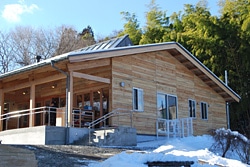 |
| Kesennuma Child Support Centre. |
 |
| A welcome board set up at the entrance. |
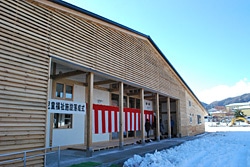 |
| Child welfare facilities in Watari Town. |
 |
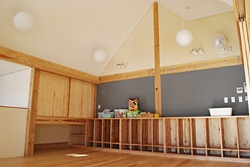 |
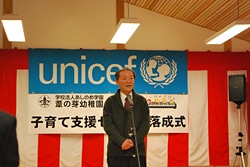 |
| Ashinome Kindergarten Principal Junichi Onodera. |
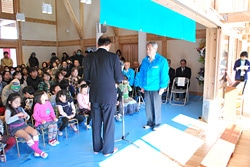 |
| A letter of gratitude presented to JCU on behalf of Watari Town. |
The Japan Committee for UNICEF (JCU) has supported the reconstruction and large-scale refurbishments of preschools, kindergartens, and educational and health facilities in response to requests received from local governments in Iwate, Miyagi and Fukushima Prefectures. These areas where severely affected by the 11 March 2011 earthquake and tsunami. The completion ceremonies for the final two child welfare facilities were held on Saturday, 19 January in Kesennuma City, Miyagi Prefecture and Sunday, 20 January in Watari Town, Miyagi Prefecture.
The affected areas of the Tohoku region have suffered abnormally cold weather this year. On 18 January, the day before the first completion ceremony, the coastline of Miyagi Prefecture was even hit with a rare snow storm. The days of the completion ceremonies, however, were blessed with sunny blue skies, making the adverse weather conditions the day before seem like a dream. The ceremonies were attended by Vice-Mayor of Kesennuma City Yasuhiro Muneura and Watari Town Mayor Kunio Saito, teachers and students from the schools, and local residents.
In Kesennuma the newly constructed child support centre will be used widely by local children. At the opening ceremony, Ashinome Kindergarten Principal Junichi Onodera spoke of his aspirations for the new child support centre, saying, "Kesennuma still has a long way to go on the road to reconstruction, but I believe it to be our responsibility—those of us involved in caring for preschool-age children—to provide children with the time and space necessary to develop their creative imaginations without being forced to endure such tough conditions." Looking back on the past two years since the disaster, he added, "This facility sufficiently fulfills that responsibility. I intend to exert every effort to contribute to the sound growth of the children of Kesennua, for they are our future."
The child welfare facility in Watari Town was constructed as a facility that could be used by local children and children attending Yoshida Nursery Centre, which lost its school building to the tsunami. Yumiko Suzuki, a teacher at Yoshida Nursery Centre, recalled the events of 11 March 2011: "On the day of the earthquake the children ran to adjacent Nagatoro Primary School for help. The children were scared of the disaster. They were terrified. That is why I hope this new facility will give them hope for a brighter future." Ms. Suzuki looks to the new child welfare facility to serve as a driving forward force for the community.
Thanks to the generous support of countless donors, these two new buildings were successfully completed as part of the kindergarten and preschool reconstruction assistance project. Reconstruction assistance for permanent kindergarten and preschool buildings has been implemented based on the following three basic philosophies and five basic principles:
3 basic philosophies
5 basic principles
The designs for the facilities are the culmination of numerous negotiations among teachers and other relevant parties. Local construction materials, including trees damaged in the disaster, were used for construction to create school buildings that created a warm, welcoming feel. One of the walls was even created by the children themselves. In this way, each facility has its own character; the result of many people's ideas infused into one. Watari Town Mayor Kunio Saito noted, "I think that one of the most effective cures for the wounded hearts of the children, parents and evacuees living near the temporary housing has been to directly observe the advancing construction work—the setting up of scaffolding and the actual building." These facilities will serve as a long-term host for local residents with the objective of supporting children impacted by the disaster and the community.
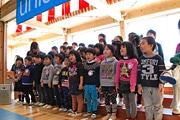 |
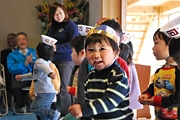 |
 |
Following the opening ceremony, a song and dance were performed by children from Kesennuma and Watari as a way to express their gratitude for the new buildings. On a bright, sunny day, the cheerful voices of children resonated through the new building's halls, the pine tree construction of which will always be a reminder of the 11 March 2011 Great East Japan Earthquake.
All photo credits: © Japan Committee for UNICEF
Click here to learn about Kesennuma City Child Support Centre "Greeting Wall"